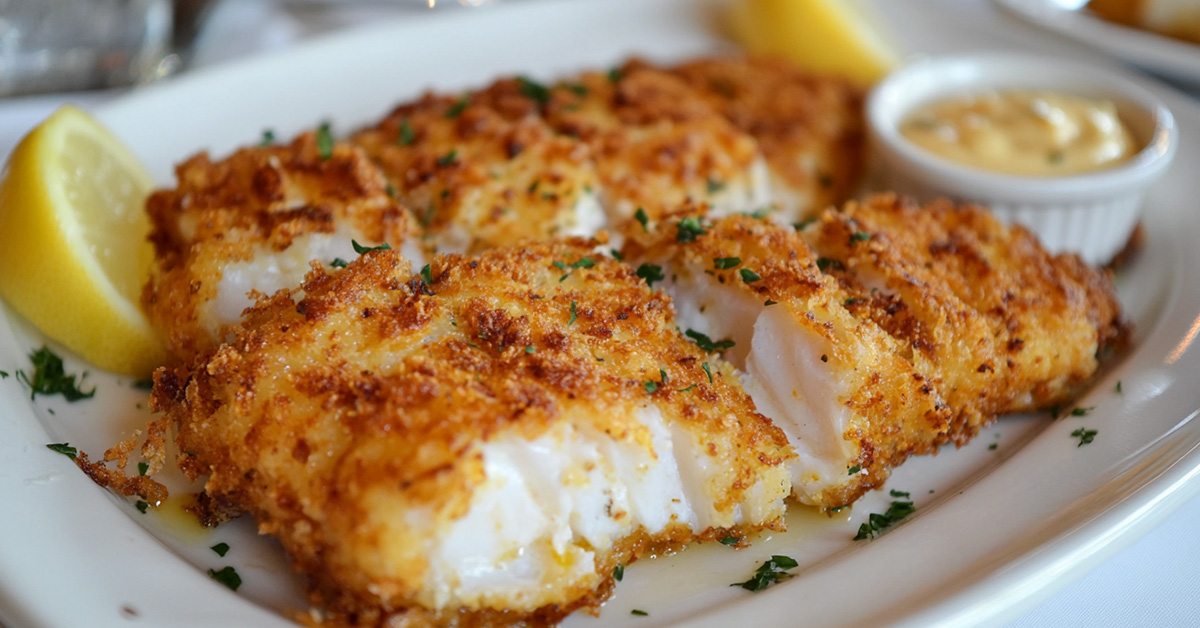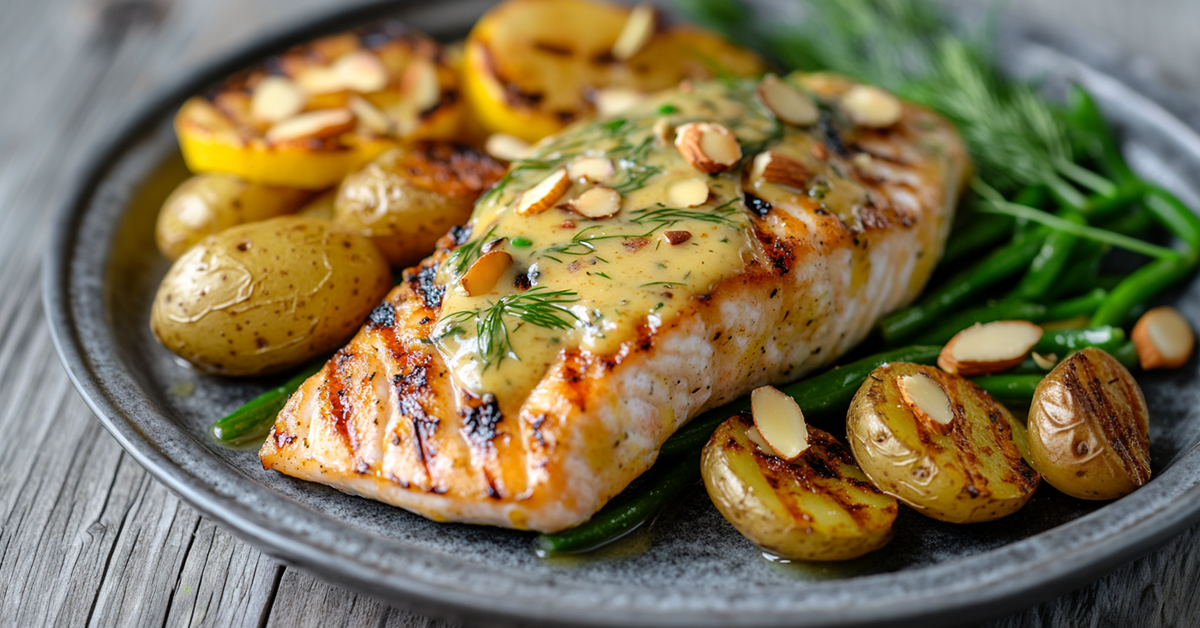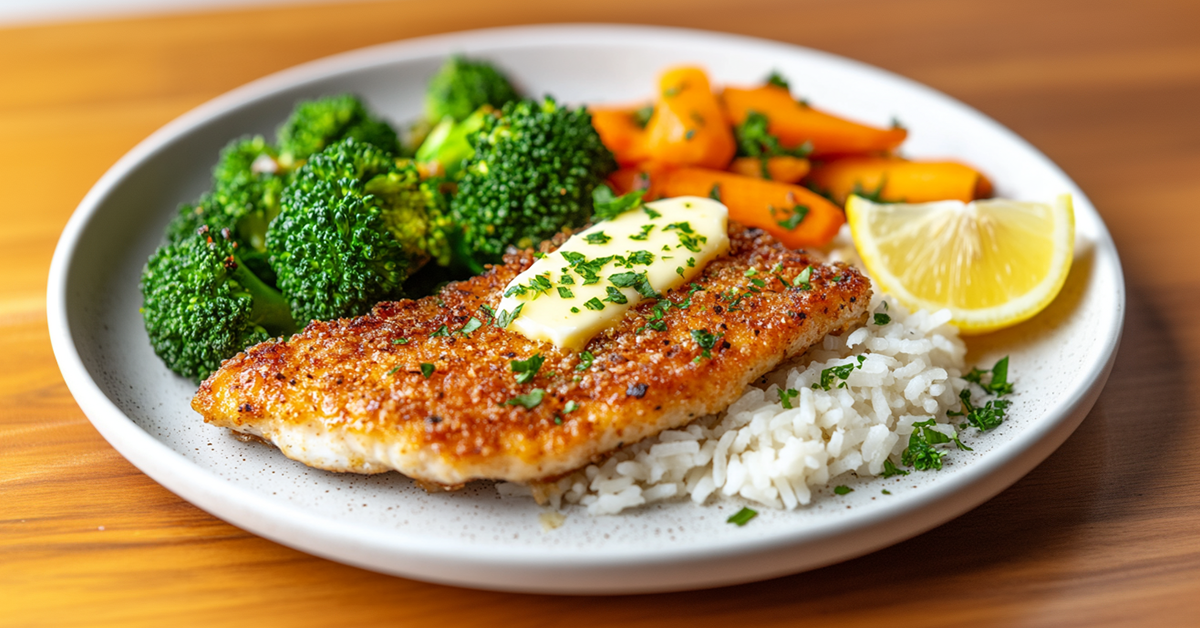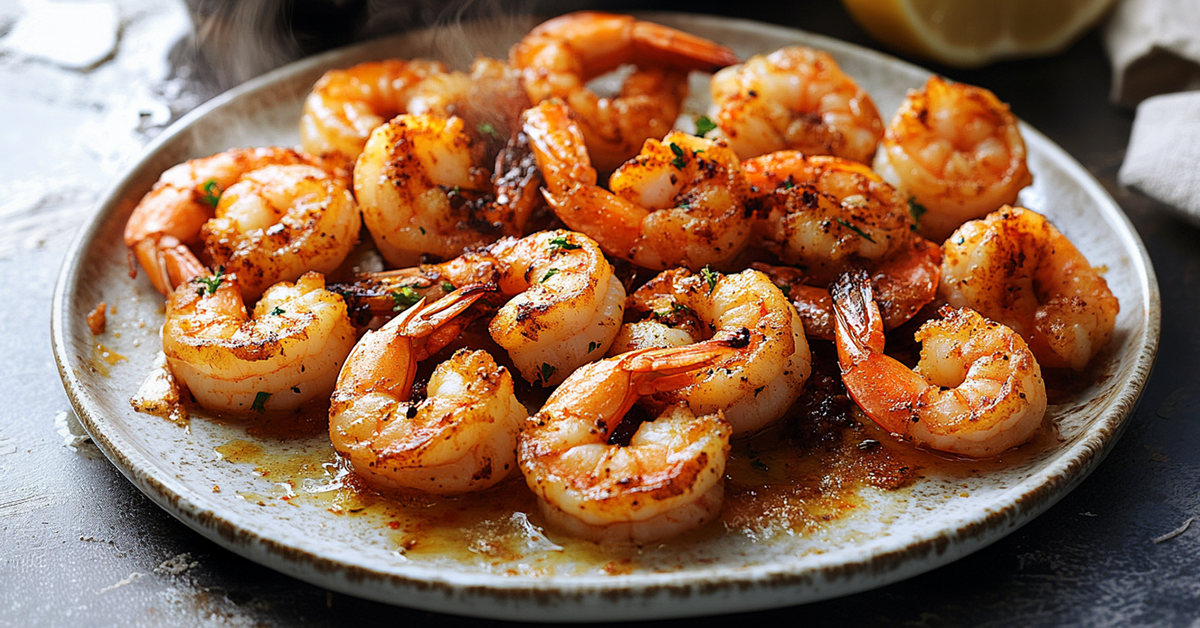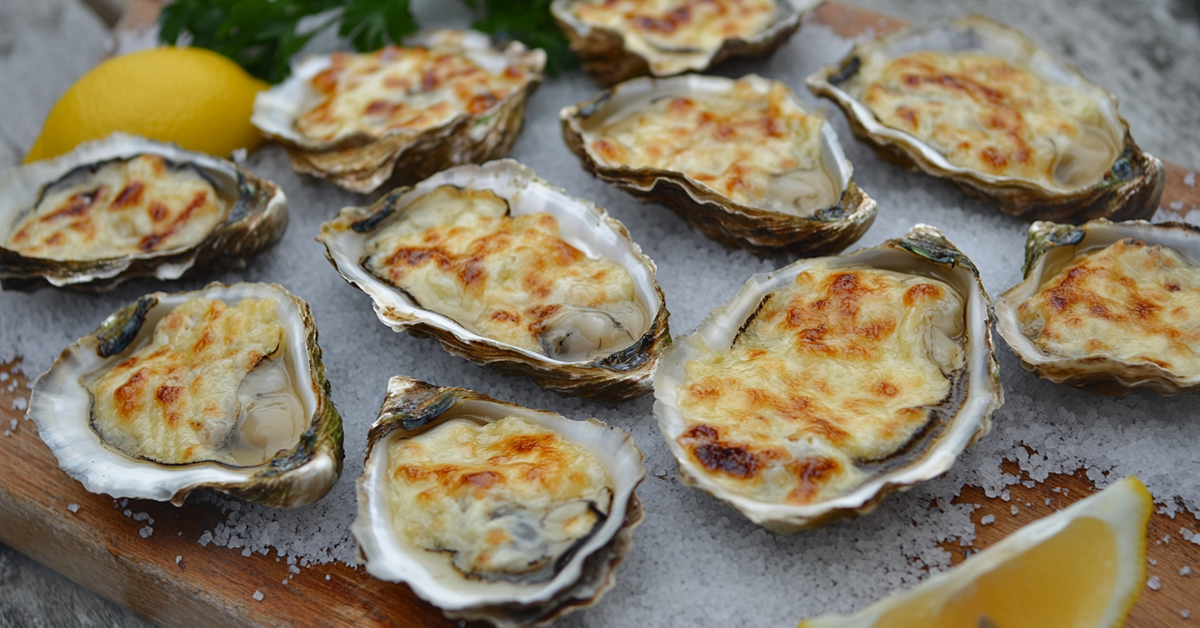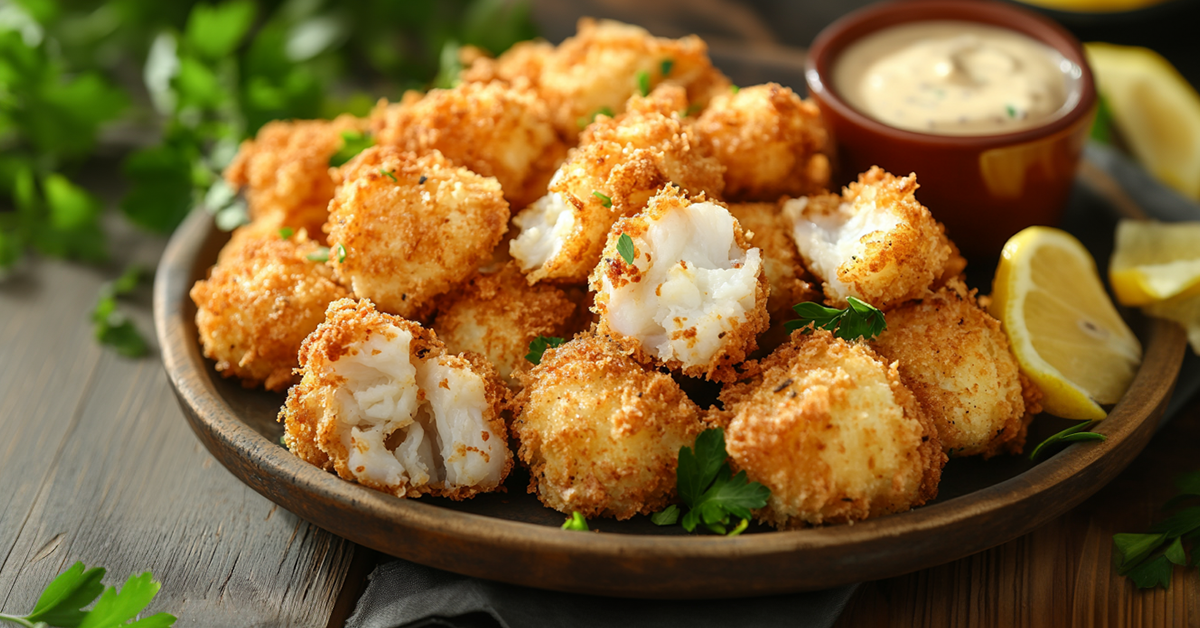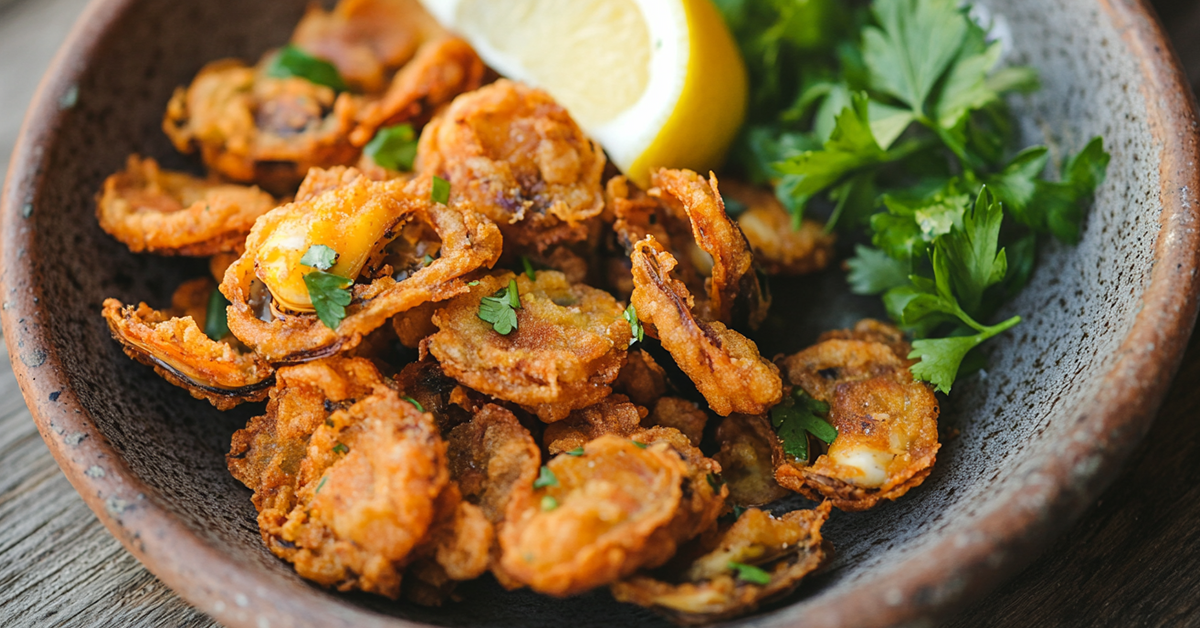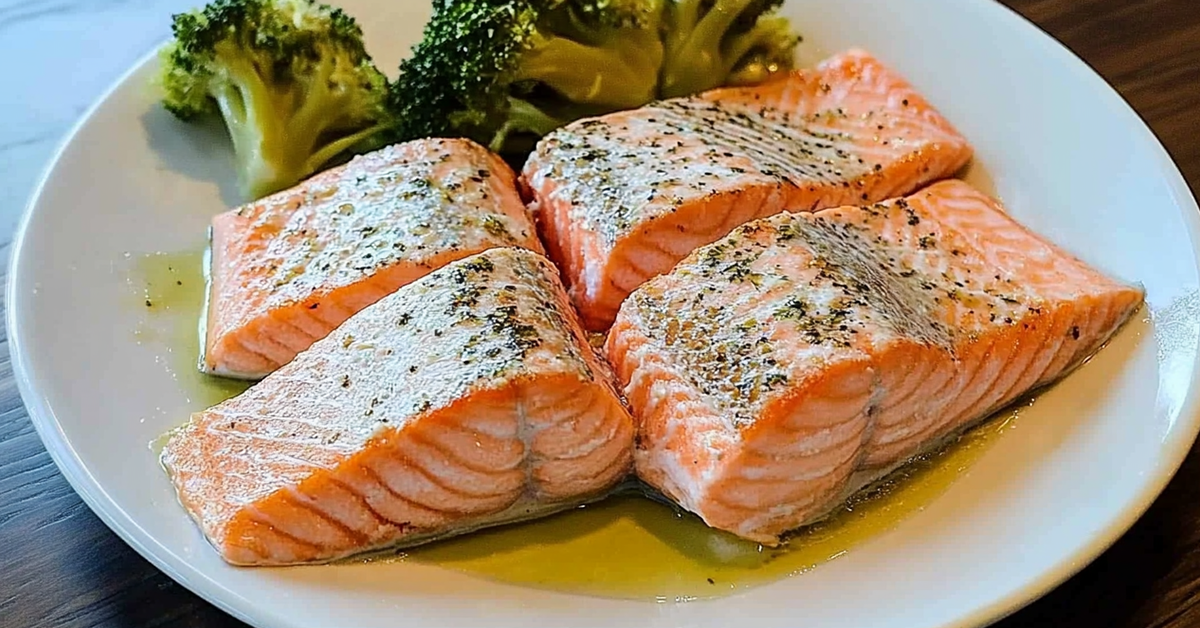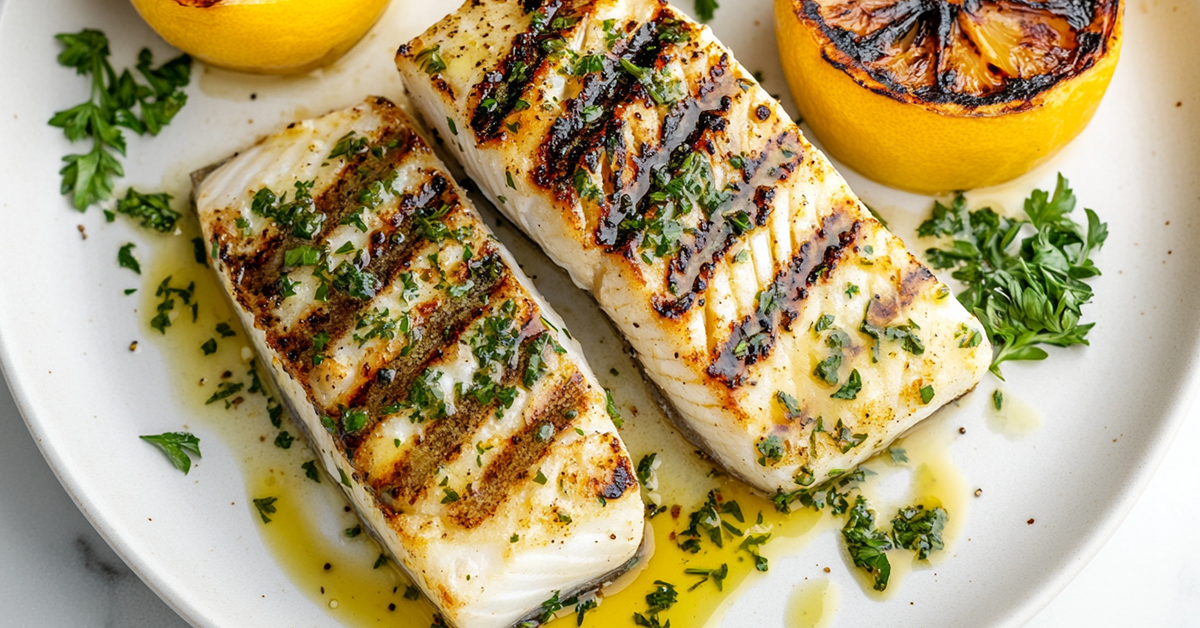A perfectly fried grouper delivers an irresistible combination – crispy exterior with tender, flaky meat inside. This prized catch stands out with its mild flavor and firm texture that turns golden and delectable after proper frying.
The versatility of grouper makes it perfect for different cooking styles. You can prepare a lightly seasoned pan-fried version or create crunchy deep-fried bites. Becoming skilled at this grouper recipe will add an impressive dish to your kitchen arsenal. The right cut and perfect crispiness are the foundations of restaurant-quality fried grouper you can make at home.
This piece shows you multiple ways to fry grouper with detailed cooking techniques. Expert tips ensure your fish turns out perfectly each time. The nutritional benefits and serving suggestions help you make the most of this adaptable seafood.
Table of Contents
What Makes Fried Grouper Special?
At the time you’re learning about seafood options, grouper stands out as a premium choice to fry. The fish’s remarkable features make it a natural fit for this cooking method.
Grouper’s exceptional meat structure sets it apart. The fish comes with thick, firm filets that won’t break apart while frying – something you don’t get with more delicate fish. The meat stays moist and succulent while developing that beautiful golden-brown crust.
The sort of thing I love about grouper is its unique flavor profile. Seafood enthusiasts choose it because:
- A mild, sweet taste that appeals to both fish lovers and those new to seafood.
- Dense, white flesh that absorbs seasonings beautifully.
- Natural moisture content that keeps the meat tender during cooking.
- Large, meaty flakes that provide satisfying texture.
Grouper’s unique protein structure creates the perfect canvas for different cooking styles. The meat stays dense enough to handle high temperatures without losing its natural juices. This creates that perfect contrast between the crispy exterior and tender interior.
There’s another reason why grouper stands out – it works well with different frying methods. The fish adapts beautifully whether you pan-fry it with a light coating or deep-fry it with substantial batter. Heat brings out the meat’s natural sweetness and creates a delightful caramelization that enhances its flavor.
Grouper’s size and thickness work to your advantage. The substantial filets cook evenly and you retain control over the final result. You can achieve that restaurant-quality finish easily – a beautiful golden exterior with perfectly cooked interior.
The fish knows how to play well with different seasonings too. You can stick to simple salt and pepper or experiment with complex spice blends. Grouper’s mild base flavor lets you try various combinations while keeping its distinctive character intact.
Read also: Fried Cod Recipe
Different Styles of Fried Grouper Recipes
The ever-changing world of fried grouper has a delightful array of preparation styles. Each style brings its own special twist to this beloved seafood dish. You can enjoy this versatile fish through Southern-style deep-frying or light pan-searing techniques.
The classic Southern-style preparation needs a hearty coating that creates an irresistibly crunchy exterior. You can pick from several coating options to get your perfect texture:
- Traditional seasoned flour.
- Cornmeal and flour mixture.
- Panko breadcrumbs.
- Beer batter coating.
- Tempura-style batter.
Pan-frying grouper lets the fish’s natural flavors shine through. A light dusting of seasoned flour and a quick sear in hot oil creates a delicate crust that keeps the fish moist. This technique works great especially when you have fresh grouper from coastal regions.
The Mediterranean style takes a lighter approach. You’ll just need to coat the grouper with herbs and a touch of olive oil before frying. This method brings out the fish’s natural sweetness while aromatic herbs like oregano, thyme, and rosemary improve its flavor profile.
The Cajun-style preparation is perfect if you love bold flavors. Spicy seasonings in the coating turn your grouper into a zesty, flavorful dish that goes perfectly with traditional Southern sides. The seasoning blend usually has paprika, cayenne, garlic powder, and other aromatic spices that create a rich taste.
Caribbean-inspired preparations add a tropical twist. You’ll coat the grouper in coconut flakes mixed with breadcrumbs before frying. This style adds a subtle sweetness and unique texture that makes the fish’s natural taste even better.
The Asian-inspired approach brings another dimension to the table. You might find grouper prepared with a light tempura batter or seasoned with ginger and garlic before flash-frying. This method gives you an exceptionally crispy exterior while keeping the fish tender inside.
Grouper bites offer a modern spin on this classic fish. These smaller pieces work great as appetizers or casual dining options. The bite-sized portions can take any of these coating styles and get even crispier because of their smaller size.
Read also: Cornmeal Fish Fry Recipe
Essential Tips for Making the Best Fried Grouper
The perfect fried grouper requires you to become skilled at essential techniques and learn about significant preparation steps. You’ll need to focus on several elements to achieve restaurant-quality results.
Temperature control makes all the difference in frying grouper. Keep your oil at a steady temperature between 350-375°F. Your coating will burn before the fish cooks if it’s too hot, and you’ll get greasy, soggy results if it’s too cool. A kitchen thermometer will be your trusted companion throughout this process.
Your grouper filets need to be completely dry before cooking starts. Use paper towels to pat them really well and remove excess moisture. This step will help you get that crispy exterior you want.
These preparation steps will lift your fried grouper to new heights:
- Let the fish reach room temperature before cooking.
- Season your coating mixture well before dredging.
- Press the coating firmly onto the fish to ensure good adhesion.
- Allow the coated fish to rest for 5-10 minutes before frying.
- Use neutral oil with a high smoke point.
- Don’t overcrowd the pan – leave space between pieces.
Oil selection is a vital part of your success. Oils like canola, peanut, or vegetable oil can handle high temperatures without breaking down. These options won’t affect your grouper’s natural flavor either.
Your coating needs consistent application. A uniform distribution of flour, breadcrumbs, or their combination works best. Double-dredging gives you an extra-crispy crust that locks in moisture – first in flour, then egg wash, and finally another coating.
The right timing can make or break your grouper. Most filets need 3-4 minutes per side, depending on thickness. Watch for a golden-brown color and resist flipping the fish multiple times. A single turn usually does the job.
You’ll know your grouper is ready by watching for visual cues. The fish should look opaque and flake easily with a fork. A meat thermometer can help if you’re unsure – the thickest part should reach 145°F.
A wire rack works better than paper towels for resting your fried grouper. This technique keeps the bottom crispy and lets excess oil drain while maintaining that perfect exterior you worked to achieve.
Read also: Fried Whiting Recipe
The Art of Pan Frying Grouper
Becoming skilled at pan-frying grouper needs proper technique, timing, and attention to detail. The perfect pan-fried grouper experience begins with the right pan selection. A heavy-bottomed skillet, preferably cast iron or stainless steel, will give a perfect cooking surface to achieve that golden-brown crust.
The pan should heat properly. Set it over medium-high heat and let it warm up. A few drops of water will dance and evaporate immediately upon contact when ready. Add your chosen oil and wait for it to shimmer – this signals the perfect temperature for your seasoned grouper filets.
These significant checkpoints matter when placing grouper in the pan:
- Position filets away from you to prevent oil splatter.
- Leave adequate space between pieces for even cooking.
- Listen for a steady sizzle – too loud means too hot.
- Watch for golden-brown color developing around edges.
- Resist the urge to move the fish prematurely.
Patience plays a vital role during cooking. The grouper needs time to develop a proper crust before flipping. The filet’s edges will become opaque, gradually working up the sides. This visual cue and a cooking time of about 3-4 minutes signal the right moment to turn the fish.
The flip is critical – a thin, wide spatula helps gently lift and turn the grouper. Another 30 seconds of waiting helps if you meet resistance. A properly crusted filet releases from the pan easily. Heat should reduce slightly after flipping to ensure even cooking without burning.
The heat needs monitoring throughout. Lower the temperature immediately if the pan starts smoking. A gentle sizzle from medium-high heat works best. This steady temperature helps your grouper develop a beautiful golden crust while staying moist inside.
The grouper’s firmness indicates doneness. A gentle press on the thickest part with your spatula should feel slightly firm but still have some give. The flesh that turns just opaque throughout shows perfect cooking while retaining its natural moisture.
Carryover cooking continues even after removing fish from heat. Your pan-fried grouper should transfer to a warm plate slightly before reaching full doneness. This approach ensures the fish won’t overcook while resting, creating that perfect balance of crispy exterior and succulent interior.
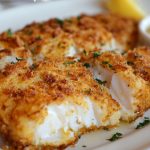
Fried Grouper Recipe
- Total Time: 23 minutes
Description
This delectable fried grouper recipe will revolutionize your kitchen into a seafood haven and give you restaurant-quality results. The recipe blends traditional Southern cooking techniques with modern culinary precision to create perfectly crispy exterior and tender, flaky interior.
The classic fried grouper features a golden-brown crust that protects the succulent fish beneath. Each bite delivers a satisfying crunch and reveals the sweet, mild flavor of perfectly cooked grouper. Your family and guests will be impressed with these amazing results.
Ingredients
- 2 pounds fresh grouper filets.
- 2 cups all-purpose flour.
- 2 large eggs.
- ½ cup water.
- 2 cups Italian-style breadcrumbs.
- 1 tablespoon seasoning salt.
- Vegetable or peanut oil for frying.
- Lemon wedges for serving.
Instructions
- Cut grouper filets into portions that are no thicker than ½ inch to ensure even cooking.
- Season fish pieces with seasoning salt and let them rest for 10 minutes.
- Set up your dredging station:
- Pour flour onto a plate.
- Whisk eggs and water in a bowl.
- Place breadcrumbs on another plate.
- Heat oil in a deep pan or skillet to 375°F.
- Dredge each grouper piece:
- First in flour, shake off excess.
- Then in egg mixture, let excess drip.
- Finally in breadcrumbs for even coating.
- Place the coated fish carefully in hot oil and fry for 2-3 minutes per side until golden brown.
- Place on a wire rack to drain excess oil.
Notes
Your filets should be completely dry before coating for best results.
Keep oil temperature between 365-375°F for perfect crispiness.
Don’t overcrowd the pan – cook in batches if needed.
Fish is done when it flakes easily with a fork.
- Prep Time: 15 minutes
- Cook Time: 8 minutes
- Category: Seafood
- Method: Frying
Health Benefits of Grouper Fish
Grouper isn’t just delicious and versatile – it packs impressive health benefits that make it perfect for a balanced diet. This lean fish delivers great nutritional value and leaves you feeling satisfied.
Adding grouper to your meals gives you a protein-rich food that helps maintain and build muscle. The fish’s protein structure works well because your body digests it easily, and it contains all the essential amino acids you need.
Key nutrients you’ll find in grouper include:
- High-quality protein for muscle health.
- Essential B vitamins for energy metabolism.
- Selenium for immune system support.
- Potassium for heart health.
- Magnesium for bone strength.
- Omega-3 fatty acids for brain function.
Your heart health improves with regular grouper consumption since it’s naturally low in saturated fats. The fish retains its heart-healthy properties even when fried, provided you use the right oils and cooking techniques.
Brain health gets a boost from grouper too. The fish’s omega-3 fatty acids support cognitive function and help maintain mental clarity. Healthy cooking oils preserve these valuable nutrients, though frying might reduce some benefits.
Grouper fits perfectly into a weight-management plan. The high protein content keeps you feeling full longer and might help reduce overall calorie intake. Even the fried version can work in a balanced diet if you follow our recipe section’s techniques and enjoy it in moderation.
The fish’s minerals deserve a closer look. Grouper contains plenty of selenium, which is a vital part of your body’s antioxidant defenses. This mineral teams up with vitamin E to protect cells and boost immune function.
People with digestive concerns often find grouper easier to process than other protein sources. The fish’s mild flavor and tender texture – whether pan-fried or deep-fried – make it ideal for sensitive stomachs.
Bone health improves thanks to grouper’s calcium and phosphorus content. These minerals work together to keep bones and teeth strong. The fish’s natural vitamin D helps your body absorb and use these minerals better.
References:
– humanitas
– castandspear
Note that you can maximize these health benefits by trying different cooking methods. The pan-frying approach in our recipe section, combined with heart-healthy oils, preserves the nutrients while delivering that delicious taste you love.
Nutritional Value of Fried Grouper
The nutritional makeup of fried grouper can help you make smart choices about adding this tasty fish to your meals. Your cooking method, serving size, and coating choices all shape its nutritional value.
A standard 6-ounce serving of fried grouper gives you:
- Protein: High-quality complete protein.
- Calories: Moderate caloric density.
- Fats: Healthy fats plus cooking oil.
- Carbohydrates: Mostly from coating.
- Minerals: Rich in essential minerals.
- Vitamins: B-complex vitamins.
Your cooking method’s choice substantially affects your grouper’s nutrition. Pan-fried grouper has fewer calories than deep-fried because it soaks up less oil. A light coating and pan-frying keeps the fish’s natural goodness while adding minimal calories.
Your choice of breading is a vital part of the overall nutrition. A light flour coating adds fewer calories than thick batter or breadcrumbs. Each tablespoon of absorbed oil adds about 120 calories to your meal.
Portion control matters a lot with fried grouper. The fish itself is lean, but frying adds calories quickly. A reasonable portion lets you enjoy this delicious dish as part of a balanced diet. You might want to add steamed vegetables or a fresh salad to create a complete meal.
Protein remains one of fried grouper’s best features. The fish keeps its high-quality protein structure after cooking and provides amino acids your body needs. Heat actually makes some proteins easier for your body to use.
Heart-healthy oils like olive or avocado oil can improve your grouper’s nutrition when pan-frying. These oils add good monounsaturated fats and help your body absorb the fish’s vitamins better.
Reference: Eat This Much
Most minerals stay in your fried grouper through cooking. You’ll get selenium, potassium, and phosphorus, though high heat might affect some minerals. The crispy outside adds texture and locks in these nutrients.
Serving Suggestions for Fried Grouper
The right sides and presentation can boost your fried grouper into an exceptional dining experience. Thoughtfully selected accompaniments complement this golden-crusted delight perfectly.
A classic coastal presentation pairs your fried grouper with traditional sides that lift its natural flavors. Bright citrusy coleslaw creates a perfect contrast to the crispy fish. Hush puppies or cornbread add satisfying Southern comfort. Fresh lemon wedges and homemade tartar sauce round out this timeless combination.
Your side dishes can match the season and occasion:
- Light summer sides: Grilled corn salad, cucumber-tomato relish, or watermelon feta salad.
- Hearty winter accompaniments: Roasted root vegetables, creamy mashed potatoes, or wild rice pilaf.
- Quick casual options: French fries, sweet potato wedges, or crispy onion rings.
- Health-conscious choices: Quinoa salad, steamed asparagus, or Mediterranean roasted vegetables.
Sauce pairings are vital to your fried grouper’s success. Traditional tartar sauce works great, but you might want to try remoulade sauce for a Cajun twist. A light citrus butter sauce adds elegance, while zesty mango salsa or pineapple chutney brings tropical flair.
An elegant presentation starts with placing your fried grouper on mixed greens or wilted spinach. Fresh herbs like parsley or dill make beautiful garnishes. Colorful vegetables create an Instagram-worthy plate. Smaller portions work great as upscale appetizers at dinner parties.
Your fried grouper becomes a casual feast on a toasted brioche bun. Add lettuce, tomato, and your favorite sauce. Pan-fried versions work best for these sandwiches, making them ideal for weekend lunches or easy dinners.
A DIY toppings bar makes seafood gatherings more fun. Set out various sauces, fresh herbs, citrus wedges, and pickled vegetables. Your guests can customize their plates while enjoying your perfectly fried grouper.
Temperature contrast plays a significant role. Cool, refreshing sides like cucumber salad or chilled roasted pepper strips pair beautifully with hot, crispy grouper. These temperature variations boost the overall experience and texture contrasts.
Busy weeknights call for advance prep of your sides. This lets you focus on getting that perfect golden crust. Cold sides taste even better when made ahead, as their flavors develop while you concentrate on frying your fish.
Grouper in Culinary Traditions
Grouper has become a beloved ingredient in many culinary traditions along coastlines around the world. This fish’s adaptability, especially when fried, makes it a kitchen favorite from the Caribbean to the Mediterranean.
Fried grouper means more than just food in the American South – it’s a celebration of coastal heritage. Golden-brown, crispy grouper served at family gatherings and local festivals shows its cultural importance. No Southern food experience feels complete without tasting this regional specialty.
Regional interpretations of fried grouper show how adaptable this fish can be in different culinary scenes:
- Mediterranean coastal towns serve lightly fried grouper with olive oil and herbs.
- Caribbean recipes mix local spices with coconut-based coatings.
- Gulf Coast cooks prefer cornmeal-based crusts.
- Asian coastal areas use lighter tempura-style batters.
- Florida’s coastal communities make it their signature sandwich.
The rise of grouper cooking methods shows how traditional techniques shape modern cooking. Chefs today draw inspiration from the time-tested practice of seasoning with local herbs and spices, adding their creative touches to these classic dishes.
This fish’s culinary heritage reveals fascinating cultural intersections. Mexican coastal areas blend indigenous cooking methods with Spanish influences to prepare grouper. Mediterranean cooking styles have shaped today’s grouper preparations with their focus on quality ingredients that highlight the fish’s natural taste.
Coastal families have passed down their grouper frying techniques through generations. Each region adds its unique touch. The simple technique stays the same, but different seasonings, coatings, and side dishes tell stories of local flavors and ingredients.
Today’s chefs are bringing new life to traditional grouper recipes. They build on tested methods while adding modern twists. This approach will give a fresh take on classic fried grouper without losing its rich heritage.
Traditional grouper cooking has spread beyond the coast. Inland restaurants and home cooks have embraced these methods. Fried grouper’s popularity has grown far from its seaside origins, yet it keeps its maritime connection strong.
Read also: Fried Fish and Rice Recipe
Frequently Asked Questions About Fried Grouper
Let’s tackle the most common questions about preparing and serving fried grouper. These answers will help you become skilled at making this delicious dish and fix any issues you face.
How do I know when my fried grouper is fully cooked? The fish turns golden brown outside and flakes with a fork when it’s ready. Check that the internal temperature hits 145°F at its thickest part. The meat should look opaque throughout, not translucent.
Why does my coating fall off during frying? Your coating might separate because you missed some vital steps. Make sure the fish is dry before coating it. Press the breading firmly and let it rest 5-10 minutes before frying. The fish should stay still while cooking.
Can I prepare fried grouper in advance? Fresh fried grouper tastes best, but you can prep some parts ahead. Get your flour mixture seasoned, set up your dredging station, and cut the fish early. The actual frying needs to happen right before serving to keep that crispy texture.
What’s the best oil temperature for frying grouper? Keep your oil between 350-375°F to get the best results. The coating burns before the fish cooks if it’s too hot. Your grouper gets greasy if it’s too cool. A thermometer helps you watch the temperature.
How do I store leftover fried grouper? Put your leftover fried grouper in an airtight container and refrigerate it up to 2 days. Reheat it in a 350°F oven for 10-15 minutes. Skip the microwave – it makes the coating soggy.
What are signs of fresh grouper? Fresh grouper has firm, white flesh without discoloration and a mild, clean ocean smell. Stay away from fish with strong fishy odors or separating flesh. Look for shiny, metallic skin instead of dull or slimy texture.
Can I use frozen grouper for frying? Frozen grouper works fine if you thaw it in the refrigerator overnight. The fish needs to be completely dry before coating since extra moisture from freezing affects your crispy result.
What’s the difference between pan-frying and deep-frying grouper? Pan-frying uses less oil and gives better cooking control. Deep-frying covers the coating more evenly. You’ll get a lighter dish with pan-frying, while deep-frying creates a thicker, crunchier crust.
How thick should I cut my grouper filets? Cut filets about ½-inch thick to cook them evenly. This thickness lets the fish cook through while developing a golden crust. Lower heat and longer cooking time work better for thicker cuts.
What should I do if my oil starts smoking? Take the pan off heat right away if your oil smokes and lower the temperature. Smoking means the oil’s too hot and could make your fish taste bitter. Let it cool a bit before you start cooking again at a lower temperature.
You may like also: Mojarra Frita Recipe
Conclusion
Fried grouper makes a versatile seafood dish that combines amazing taste with great nutrition. The quality of your dish depends on becoming skilled at the basics – selecting fresh filets and creating that perfect golden crust.
The right temperature control, coating methods, and timing will help you create restaurant-quality fried grouper at home. Each preparation style, from Southern-fried to Mediterranean-inspired recipes, brings unique flavors while keeping the fish’s natural sweetness and tender texture intact.
Simple preparations will help build your confidence before you try different coatings and regional variations. This classic seafood dish will soon become a regular part of your cooking lineup. Your family and guests will love its crispy exterior and perfectly flaky center.

